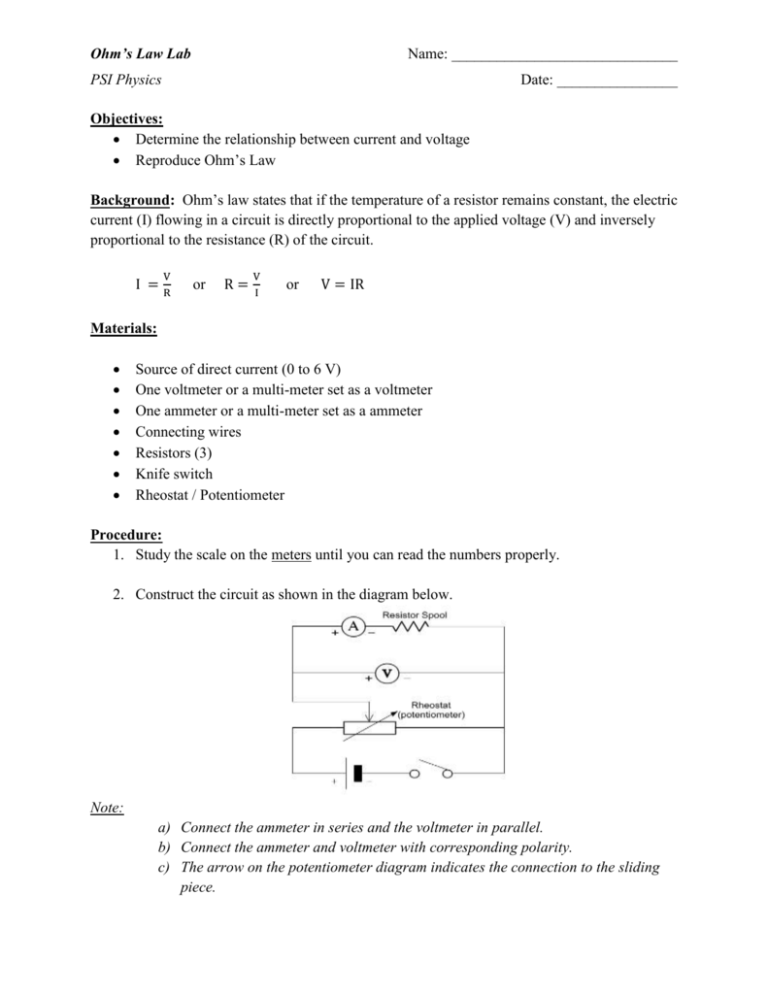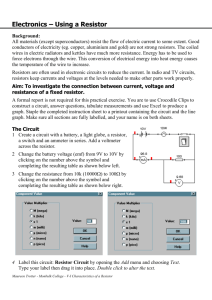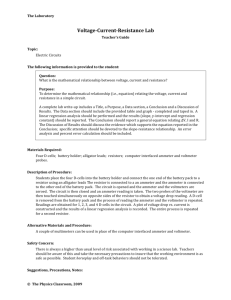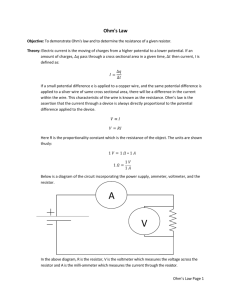Complete Ohm's Law Lab
advertisement

Ohm’s Law Lab Name: ______________________________ PSI Physics Date: ________________ Objectives: Determine the relationship between current and voltage Reproduce Ohm’s Law Background: Ohm’s law states that if the temperature of a resistor remains constant, the electric current (I) flowing in a circuit is directly proportional to the applied voltage (V) and inversely proportional to the resistance (R) of the circuit. V I =R or R= V I or V = IR Materials: Source of direct current (0 to 6 V) One voltmeter or a multi-meter set as a voltmeter One ammeter or a multi-meter set as a ammeter Connecting wires Resistors (3) Knife switch Rheostat / Potentiometer Procedure: 1. Study the scale on the meters until you can read the numbers properly. 2. Construct the circuit as shown in the diagram below. Note: a) Connect the ammeter in series and the voltmeter in parallel. b) Connect the ammeter and voltmeter with corresponding polarity. c) The arrow on the potentiometer diagram indicates the connection to the sliding piece. 3. Leave the knife switch open until your instructor has checked your circuit and given you permission to close it. You will perform the following for three different resistors. 4. Slowly move the slider across the potentiometer until the ammeter registers a small current at a mark on the ammeter. 5. For this position, measure and record this current and voltage. 6. Increment the current seven times recording both the current and voltage in the table below. Data Collection: Table 1: In this table, you will record the values for the voltage (V) across three (3) different resistors, as well as the value of current (I) that flows through the resistors. R1 R2 I (amps) V (volts) © NJCTL.ORG 2013 I (amps) PSI Physics V (volts) R3 I (amps) V (volts) 2 Data Analysis: Calculate the resistance for each of the three experiments: 1. Graph the voltage vs. current for each resistor on the graph paper provided. Include a line of best fit for your data points. 𝑦 −𝑦 2. Calculate the slope of the line of best fit. Remember, 𝑆𝑙𝑜𝑝𝑒 = 𝑚 = 𝑥2 −𝑥1 2 1 Resistor 1 Resistor 2 Resistor 3 3. The resistance is the slope of the line of the graph V vs. I Record the resistance of each resistor in data table 2. 4. Your teacher will provide you with the actual resistance of each resistor. Record these values in data table 2. 5. Calculate the percent error between the experimental and actual values for each resistor. |𝑎𝑐𝑡𝑢𝑎𝑙 𝑣𝑎𝑙𝑢𝑒 − 𝑒𝑥𝑝𝑒𝑟𝑖𝑚𝑒𝑛𝑡𝑎𝑙 𝑣𝑎𝑙𝑢𝑒| % 𝐸𝑟𝑟𝑜𝑟 = 𝑥100 𝑎𝑐𝑡𝑢𝑎𝑙 𝑣𝑎𝑙𝑢𝑒 Resistor 1 Resistor 2 Resistor 3 © NJCTL.ORG 2013 PSI Physics 3 Table 2: Experimental Resistance (Ω) Actual Resistance (Ω) Percent Error Resistor 1 Resistor 2 Resistor 3 Graphs: Make sure all 3 graphs have the following: A Title, e.g. “Voltage vs Current for Resistor #1” Axes Labels with quantity and units A best-fit line - Do not connect points! Conclusion: Answer the following questions based on what you learned and your results from this lab. 1. Did the slope of your graphs match the values for each resistor? If not, give some possible reasons why. 2. The current that flows through a resistor is ____________ proportional to the applied voltage and ____________ proportional to the resistance of the resistor. 3. While measuring the resistance of a resistor (by the use of a voltmeter and an ammeter), the voltmeter is always placed in ___________ with the resistor. The ammeter is always placed in ____________ with the resistor. 4. If the voltage across a resistance is increased, the current flowing through the resistance will ____________. 5. When the resistance of a circuit is increased, the current flowing in the circuit will______________. © NJCTL.ORG 2013 PSI Physics 4 Application: 1. A 60-watt light bulb has a voltage of 120 volts applied across it and a current of 0.5 amperes flows through the bulb. What is the resistance of the light bulb? 2. What current will flow through a 120-ohm resistor if the voltage applied to it is 12 volts? 3. A resistance of 60 ohms allows 0.4 amperes of current to flow when it is connected across a battery. What is the voltage of the battery? Extension: Recreate your graphs in Excel. Determine the actual slope of the line and compare it to the slope you calculated above. Were they close? What could be the possible causes for any discrepancies between the actual and calculated slopes? Print and attach the Excel graphs to this lab report. © NJCTL.ORG 2013 PSI Physics 5








